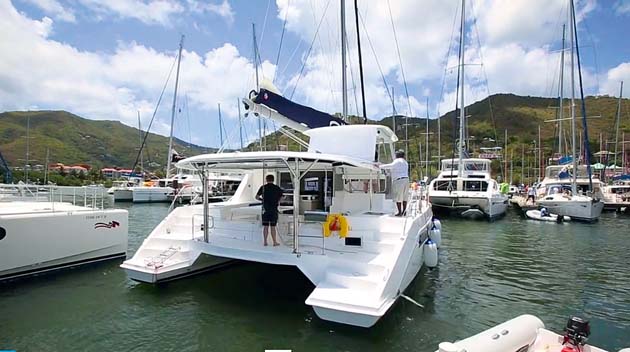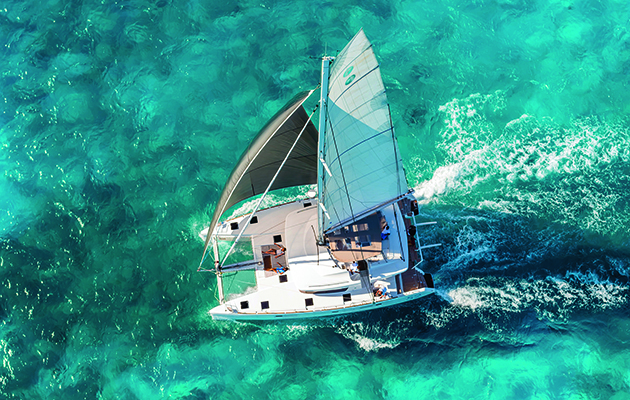To introduce our eight-part series aimed at monohull sailors adapting to a catamaran, Nigel Irens considers the difference in handling between a monohull and a multihull
The attraction of sailing a boat that offers the vast living space found on a catamaran may one day mean that your average monohull sailor is faced with the need to bone up on how to transfer his seamanship skills to catamaran sailing.
Typically this might crop up when a big family – or a group of friends – is tempted to splash out on a charter of one of these boats in some sunny holiday paradise.
To any reasonably experienced sailor stepping onto a cat shouldn’t represent a huge challenge, but the experience is certainly different enough to merit getting up to speed with it as soon as possible.
Visibility
Sitting behind the wheel of a docked cruising catamaran for the first time can, when all is said and done, be a bit daunting. All that interior space inevitably imposes some severe limits on visibility for a start.
If you’re on a boat that has separate port and starboard helm stations you may find you’ll have a great view forward and outboard, but the accommodation ‘house’ inboard of you is about as see-through as a brick wall, leaving you with no clue about what’s happening the other side of it.
OK, most of the action will be on the side of the boat against the pontoon as you leave the berth, so you’d naturally start the day here – able to see what’s happening and communicate easily with your line-handlers.
If you’re on a boat with a flybridge you’ll be able to see for miles – and you’ll certainly get a great view of the line-handling and the boat’s movement relative to the pontoon although you may not be able to see what the line handlers are doing as they may be hidden by the coachroof edges.
Coping with windage
You’ve probably taken in the fact that a catamaran with generous accommodation – and that means most of them – also has a huge amount of windage. Most of these boats have fixed centreboards (unballasted keels if you like). Although these are not the most efficient devices for fast upwind sailing they do have enough pure area to stop the boat being blown about like a loose paper bag when manoeuvring under power.

Arriving at the marina and contemplating your exit may be daunting, but cats are easier to handle under power than you might think
Although the windage issue and poor visibility may seem daunting, there is one built-in characteristic of a catamaran that is there to make your life much easier. Having two engines – especially as they are set so far apart – gives you a secret weapon that can make even a novice look like pro.
This is just as well as the rudders on the average cruising catamaran are smaller than you would like them to be if you needed to depend on them for low-speed manoeuvring. This choice is driven by the desire to reduce draught as much as possible (OK, and maybe the cost as well …).
Manoeuvring with twin engines
In reality, armed with twin engines, you can forget the rudders and just leave them amidships when manoeuvring at slow speed, so you escape that nerve-racking gambit of giving a blast ahead with full rudder and just hoping against hope that she’ll respond in time before clouting the dock (or worse).
That trick can work well on a monohull with high aspect keel and rudder and shallow ends, but on this boat it’s probably best not to be tempted to try it.
So now you’re planning how best to leave the dock and taking a look at wind strength and direction – just as you would on any boat. If you’re on a charter boat you may well find yourself moored tightly between two other catamarans so you need to be able to move the boat quite a way sideways to get clear.

Resist the temptation to use the wheels to steer and manoeuvre using the throttles until there is sufficient flow over the rudders
If your boat is fitted with a bow thruster (not very common in cats) you can push the bow away from the dock until you’re clear to head straight out. Don’t forget that the action of the bow thruster will be to rotate the boat (viewed from above) so the stern will be pushing towards the dock as it becomes the pivot point so it will need to be well fendered.
Springing off the dock
If there’s no bow thruster installed you’ll need to spring the boat off the dock by setting a spring line between the bow and a dock cleat somewhere near the stern. This will then be led back to the bow, so that the line can be released from on board by hauling in the running end.
Moving the control of the engine furthest from the dock into slow-ahead – while the boat is restrained by that spring line – should cause the stern to swing away from the dock.

The secret to springing off the dock is to use a breast line as well as a spring. Make sure you have fenders at the bow
If all goes well when the boat has swung some 45-50° from the dock you should be able to make a stern-first exit out of the space and into clear water as you release the running spring line and haul it aboard. Take care though, because this trick can go badly wrong if the two parts of the line are twisted together – even one or two turns – as the friction created will stop the line running. Even passing that running line through a heavy iron ring on the dock or quay could stop it running – and spoil your whole day.
Once again don’t forget to set fenders from the bow before starting this manoeuvre as the bow could be pushing quite hard against the dock once you apply the thrust from the engine.

You need not worry about the wheels until the cat is heading out of the fairway. By then, with flow over the rudders, you can steer normally
Before you get too wound up about the difficulties of clearing the marina for the first time you might take comfort from the knowledge that this may be the most challenging thing you’ll do all week. Try to pick a moment when there’s a lull in the wind. Too much of it will certainly make the whole operation far more difficult – and the consequences of getting it wrong more embarrassing.
Once you’re away from the marina and into clear water you can relax and find some time and space to discover the handling characteristics of this strange new beast by doing some trials – somewhere where you can repeatedly get it all wrong without damaging anything, even your pride.
Do’s and don’ts
- DO take time to consider where the breeze is coming from as windage plays a bigger part.
-
 DO master the use of twin engines to steer – the rudders on most cruising cats are small and less effective at low speeds.
DO master the use of twin engines to steer – the rudders on most cruising cats are small and less effective at low speeds. - DO take a look at the slot you need to leave from another angle such as the opposite pontoon.
- DON’T allow the spring lines to twist together or the friction will stop the line running.
- DON’T attempt your first manoeuvres in strong wind – in tropical waters things usually quieten down in the evening.
- DON’T forget that undocking will probably be the most challenging manoeuvre you’ll do for now.
Our eight-part Catamaran Sailing Skills series by Nigel Irens, in association with Pantaenius, is essential reading for anyone considering a catamaran after being more familiar with handling a monohull.
Part 2: Handling under power – How to tame that huge beast for close-quarters manoeuvring
 Series author: Nigel Irens
Series author: Nigel Irens
One name stands out when you think of multihull design: the British designer Nigel Irens.
His career began when he studied Boatyard Management at what is now Solent University before opening a sailing school in Bristol and later moving to a multihull yard. He and a friend, Mark Pridie, won their class in the 1978 Round Britain race in a salvaged Dick Newick-designed 31-footer. Later, in 1985, he won the Round Britain Race with Tony Bullimore with whom he was jointly awarded Yachtsman of the Year.
His first major design success came in 1984 when his 80ft LOA catamaran Formule Tag set a new 24-hour run, clocking 518 miles. During the 1990s it was his designs that were dominant on the racecourse: Mike Birch’s Fujicolour, Philippe Poupon’s Fleury Michon VIII, Tony Bullimore’s Apricot. Most famous of all was Ellen MacArthur’s 75ft trimaran B&Q, which beat the solo round the world record in 2005.
His designs have included cruising and racing boats, powerboats and monohulls, but it is multis he is best known for.
A special thanks to The Moorings, which supplied a 4800 cat out of their base in Tortola, BVI. www.moorings.com





 DO master the use of twin engines to steer – the rudders on most cruising cats are small and less effective at low speeds.
DO master the use of twin engines to steer – the rudders on most cruising cats are small and less effective at low speeds. Series author: Nigel Irens
Series author: Nigel Irens